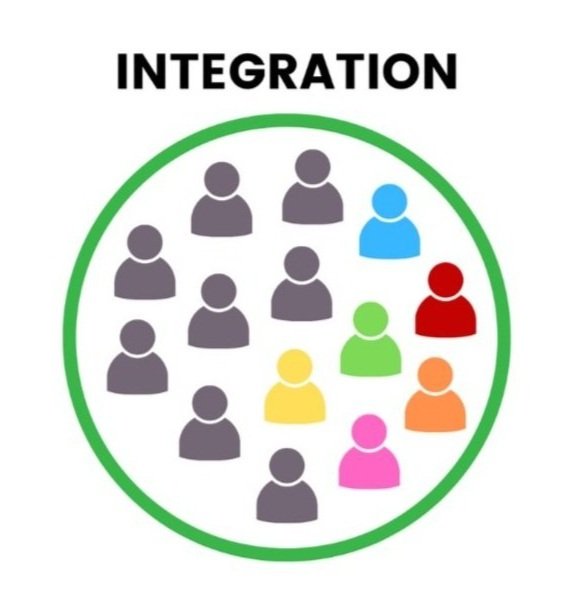Inclusion & Belonging
What is the connection between inclusion and belonging?
I’ve been exploring research and professional publications to clarify how these two terms are related and how they are different. I’d like to share what I discovered, using this graphic:
You’ll notice that this matrix has two arrows. The vertical arrow refers to whether individuals have access (high or low) to whatever is desirable - a strong education, an exclusive restaurant, a social group; the horizontal arrow refers to whether they can belong unconditionally, without changing their characteristics or whether their belonging is contingent on some “acceptable” criteria.
So let’s think about the four quadrants of this organizer in terms of K-12 education.
(Note: you could translate to anything that people would desire.)
EXCLUSION: If you don’t meet certain criteria, you are not granted access. Maybe you can’t participate in football practice if you didn’t make the team OR maybe you won’t meet with the English department if you teach another subject.
The message is that you don’t belong here. Sometimes it’s OK to be excluded and we just have to get over it. But being excluded because of one of your identities can be demoralizing and dehumanizing. For years, students with disabilities were excluded from public education. In many places, people are still barred from certain places because of their race, financial status, ethnicity, or gender.
Which exclusions are OK in your school?
INTEGRATION: You are granted access, but you have to fit in. We try to teach all our children appropriate behavior so they can “fit in” in public spaces without awkward moments. What parent hasn’t tried to subdue a 2-year-old temper tantrum in public?
Transition professionals work with young adults to develop socially appropriate work behaviors for the job site so they will fit in.
But sometimes you have to change or hide part of your identity to fit in. Some straighten their hair. Some of us change how we dress. Trying to mimic those who truly belong, maybe you suppress your “divergent” thinking, looks, and actions.
Sometimes, integration means you are only allowed on the fringes, like the students who are mainstreamed, but sit in the back of the classroom, only interacting with a paraprofessional. In short, the real you doesn’t belong. It may feel good at first, you enjoy the victory of being admitted, but the cost of not being yourself weighs on you.
SEGREGATION: There is a special place for “people like you.” Most of us enjoy going home where we belong and where we are totally accepted.
The great thing about segregated settings is that you can be fully yourself — you’re with others who appreciate you just the way you are. You unconditionally belong! It’s easy to understand parents who want their child with significant disabilities in a self-contained classroom. They believe their child will experience complete acceptance without bullying there!
But segregated children are not exposed to typical peer role models and challenging curriculum. Being protected means they may not learn the skills associated with being integrated. They won’t be prepared to navigate the complexities of interactions beyond school. Additionally, they haven’t given their typical peers (our future employers) the benefit of learning alongside people with a range of abilities, skills, and experiences.
Are some students segregated in your school in ways that are not OK — ways that perpetuate inequity?
When inclusion is done right, every individual is honored for the complex mix of identities that we each bring. In an inclusive school community we expect variability of people. Individuals learn to listen with curiosity and without judgment to alternative perspectives and learn to speak their own truths without “know it all” (I’m right and you’re wrong) domination. Truly inclusive schools are organized so that students and faculty can thrive, with opportunities to learn and opportunities to unlearn.
Maslow’s hierarchy of needs (1954) lists belonging as the third level of needs, following physiological needs (food, water, shelter) and safety (physical & psychological). His research found that belonging (friendship, connection) must occur before we humans can achieve and reach self-actualization (the highest two levels).
Have schools forgotten the importance of belonging?
To be clear, this blog isn’t about which setting is “best” for an individual. There are times in all our lives where we are excluded, and we have to cope with that reality. (My adult children went to the Renaissance Fair and didn’t invite me). There are also times when we are integrated, and we need to camouflage ourselves a bit to fit in (the first day on a new job). Sometimes it’s a relief to get together with family or a group of friends who know you completely and you can totally be yourself. There are times when those segregated settings are comforting, right?
Rather, my point is to spark your thinking about whether inclusive settings are truly inclusive.
Is inclusion with unconditional belonging an option in our schools?
If not, where do we start?
As usual, I would love to hear your response to this blog.
Reference: Cobb & Krownapple (2019). Belonging Through a Culture of Dignity. Mimi & Todd Press





